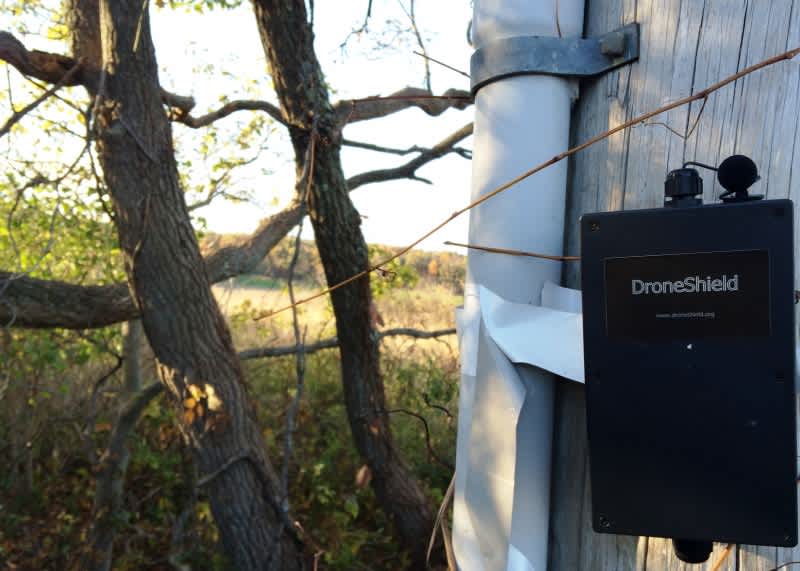Threat of Drone “Surveillance” Concerns Sportsmen
Daniel Xu 11.05.13

Even before PETA’s announcement last month regarding the launch of their controversial drone program, the topic of drones had been a controversial one among sportsmen. The specter of these unmanned aerial vehicles watching from on-high is a relatively new one, but hunters have suddenly found themselves in the spotlight as animal rights groups look to the new technology for “surveillance” purposes.
I spoke with Brian Hearing, co-founder of DroneShield, a crowd-funded technology firm that has created a device to alert users of the presence of drones. Hearing recently returned from a trip to Pennsylvania where he and his team were working to outfit a local hunting lodge with their sensors. While PETA may have made the biggest waves in the news, according to the club other animal activist groups have been using drones for years to “monitor” and harass hunters. The drones are typically flown over popular hunting grounds or near clubs to take pictures of hunters.
“We were contacted by the hunting club in Pennsylvania, who had a problem with this group,” Hearing said. “Two weeks ago we went up and deployed a network of five of our sensors which are now listening for these drones on the perimeter.”
It was not the first hunting club to request the devices. Hearing said he did not initially think that hunters would be so interested in DroneShield, which was originally designed for use against peeping toms.
“My co-founder [John Franklin] lives in a townhouse in Washington, DC, and he needed to go up and inspect the roof one day,” Hearing explained. “He was shopping around for a three-story ladder and was looking at a few hundred bucks then he heard of a drone, which was actually cheaper than a ladder. Of course, in the inaugural flight the drone crashed into his neighbor’s yard. When he retrieved the vehicle he realized he could see straight into his neighbor’s house and nobody knew.”
Concerned about the ease with which these drones could be used to invade personal privacy, Hearing and Franklin applied their background in acoustics to a new project. The DroneShield device works by listening to the acoustic signatures that drones emit when flying. The maximum range of these sensors can be several hundred feet or up to a quarter mile away, depending on the size and type of the craft targeted. Larger drones make more noise and are easier to detect, but are also more durable and boast longer flight times. Hearing relayed that the drones used near the hunting lodges he worked with were no simple RC planes.
“They are surprisingly expensive, $1,200 drones,” he said. Hearing later added in an email that the drones used by some activists can cost between $10,000 to $17,000.
The model offered by PETA to its members costs around $325. It is a price that the animal rights organization hopes is low enough to entice its members to purchase one and take on “hunter monitoring.” The legality of using one of these vehicles to “observe” hunters is a gray area, Hearing says.
“The short answer is that the laws concerning drones [are] a mess right now,” he says. “All around the country, states have different rules, different municipalities have different definitions of what air space is. The de facto law is that air space you control over land that you own is what you can use. So a lot of people think that usable air space is far high as a human, around eight feet, and anything above that is public property. Different states and different municipalities have expanded up to the FAA ceiling of 400 feet.”
Many states have already passed laws that forbid the use of recreational drones for surveillance purposes. Illinois recently passed a law specifically restricting the use of drones to interfere with hunters and anglers after an earlier announcement by PETA in April. But as long as drone operators stay within the law, they are free to fly.
Hearing described the attitude among the hunters who hired him as “fired up.” Hearing said drones may prove to be an increasingly hot-button topic as their popularity rises.
“There are these projections, depending on who you believe, that predict tens of thousands of privately-owned drones within the next 10 years, and every police department in the country is looking at acquiring them as well,” Hearing shared.
“These things are so brand-new that I don’t think many hunters know what to expect yet,” he added. “I’m not sure it’s as small of a threat [as] many hunters think it is.”
DroneShield is now working on a marine version of the device for anglers and commercial fishermen.
“Once you’re out on open water, the drones aren’t the helicopter ones anymore, they’re the six-wings type, so you would require a different database, microphone, and obviously [need to] make them waterproof.”
A “hunter’s edition” of the sensor is available for $60, while the full-scale version is $100. Hearing said that he hopes future development will make the device both smaller and cheaper.
Not all drones are used for surveillance. Many recreational drones are operated by hobbyists or researchers such as archaeologists. Drones may also be useful in detecting forest fires and search and rescue missions.
Edit added 11/5/2013: Additional information about drone price added.

